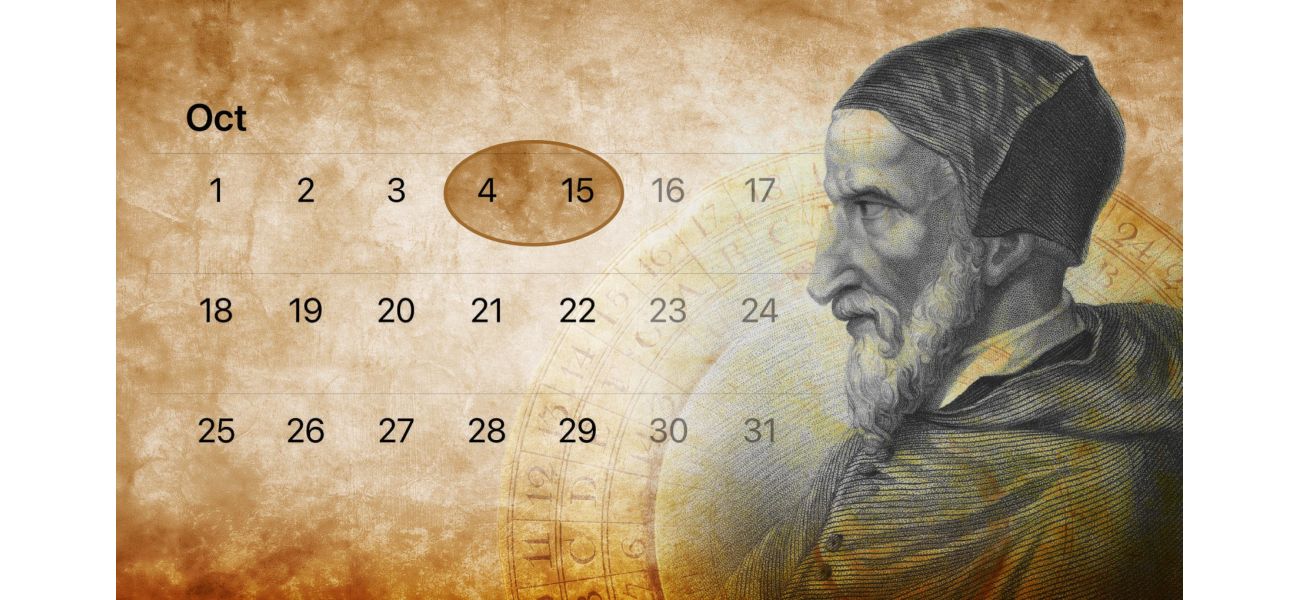In October 1582, there is a strange explanation for why 10 days are unaccounted for.
A single event reshaped how we mark time.
January 2nd 2025.

Have you ever found yourself scrolling back through the calendars on your phone, just to get a glimpse of some interesting dates? We've all been there. It's a great way to find out which day of the week you were born, or to double check the dates of past events. But have you ever scrolled back far enough to stumble upon something truly unusual?
If you were to scroll back to October 1582, you would come across a year that may not hold much significance in history. It's not as well-known as other notable years, such as 1066, 1969, or 1914. However, something significant did happen in that year, and it completely changed the way we recognize dates.
In February of 1582, Pope Gregory XIII made a decision that would have a lasting impact on our calendars. He implemented a new, reformed calendar, which we now know as the Gregorian calendar, in his honor. This decision didn't gain much attention at the time, but it has since become the standard calendar used in many parts of the world.
But what about the calendar that was used before the Gregorian calendar? Why did the church decide to make such a change? Well, the answer lies in the calendars that came before. The Gregorian calendar replaced the Julian calendar, which in turn replaced the Roman republican calendar. The Julian calendar had been in use for over a millennium, but it had a small error that added up over time.
You see, the Julian calendar was about 11 minutes and 14 seconds longer than the tropical year, which is the time it takes for the sun to return to the same position as seen from Earth. This may seem like a minor difference, but it meant that the calendar would drift by about one day every 314 years. This error became a pressing issue for the church, especially when it came to calculating the date of Easter each year.
In 325, the Council of Nicaea had decreed that Easter should fall on the first Sunday following the first full moon after the vernal equinox, which at that time, fell on March 21. However, with the shifting Julian calendar, the gap between the date set by the council and the actual vernal equinox began to grow. This posed a problem for the church, and various solutions were presented to the popes throughout the Middle Ages. But it wasn't until the Council of Trent in 1562-63 that a decree was passed, calling for the pope to fix the calendar.
It took another two decades for a solution to be found. Italian scientist Luigi Lilio's suggestions were modified by Jesuit mathematician and astronomer Christopher Clavius, after 20 years of research and consultation. Finally, in February of 1582, Pope Gregory XIII signed a papal bull, ordering that the new calendar would go into effect on October 5 of that year.
To make the necessary changes, 10 days were dropped from the calendar, moving the vernal equinox from March 11 to March 21. This change was made in October to ensure that no major Christian festivals were skipped. However, not all countries immediately adopted the new calendar. Some Protestant and Orthodox countries were hesitant to take orders from the pope.
Countries such as Austria, Spain, Portugal, Italy, Poland, and Germany's Catholic states were among the first to make the switch, jumping ahead by 10 days. This meant that crossing borders often resulted in traveling back or forward in time. Eventually, non-Catholic countries also started adopting the Gregorian calendar. The Protestant regions of Germany and the Netherlands made the switch in the 17th century, and Britain and the territories of the British Empire followed suit in 1752, spreading the use of the calendar around the world.
So, next time you're bored enough to scroll back through your phone's calendar and come across those 10 missing days, you'll know the story behind them. The Gregorian calendar may not have been immediately accepted, but it has become the standard for many countries around the world.
If you were to scroll back to October 1582, you would come across a year that may not hold much significance in history. It's not as well-known as other notable years, such as 1066, 1969, or 1914. However, something significant did happen in that year, and it completely changed the way we recognize dates.
In February of 1582, Pope Gregory XIII made a decision that would have a lasting impact on our calendars. He implemented a new, reformed calendar, which we now know as the Gregorian calendar, in his honor. This decision didn't gain much attention at the time, but it has since become the standard calendar used in many parts of the world.
But what about the calendar that was used before the Gregorian calendar? Why did the church decide to make such a change? Well, the answer lies in the calendars that came before. The Gregorian calendar replaced the Julian calendar, which in turn replaced the Roman republican calendar. The Julian calendar had been in use for over a millennium, but it had a small error that added up over time.
You see, the Julian calendar was about 11 minutes and 14 seconds longer than the tropical year, which is the time it takes for the sun to return to the same position as seen from Earth. This may seem like a minor difference, but it meant that the calendar would drift by about one day every 314 years. This error became a pressing issue for the church, especially when it came to calculating the date of Easter each year.
In 325, the Council of Nicaea had decreed that Easter should fall on the first Sunday following the first full moon after the vernal equinox, which at that time, fell on March 21. However, with the shifting Julian calendar, the gap between the date set by the council and the actual vernal equinox began to grow. This posed a problem for the church, and various solutions were presented to the popes throughout the Middle Ages. But it wasn't until the Council of Trent in 1562-63 that a decree was passed, calling for the pope to fix the calendar.
It took another two decades for a solution to be found. Italian scientist Luigi Lilio's suggestions were modified by Jesuit mathematician and astronomer Christopher Clavius, after 20 years of research and consultation. Finally, in February of 1582, Pope Gregory XIII signed a papal bull, ordering that the new calendar would go into effect on October 5 of that year.
To make the necessary changes, 10 days were dropped from the calendar, moving the vernal equinox from March 11 to March 21. This change was made in October to ensure that no major Christian festivals were skipped. However, not all countries immediately adopted the new calendar. Some Protestant and Orthodox countries were hesitant to take orders from the pope.
Countries such as Austria, Spain, Portugal, Italy, Poland, and Germany's Catholic states were among the first to make the switch, jumping ahead by 10 days. This meant that crossing borders often resulted in traveling back or forward in time. Eventually, non-Catholic countries also started adopting the Gregorian calendar. The Protestant regions of Germany and the Netherlands made the switch in the 17th century, and Britain and the territories of the British Empire followed suit in 1752, spreading the use of the calendar around the world.
So, next time you're bored enough to scroll back through your phone's calendar and come across those 10 missing days, you'll know the story behind them. The Gregorian calendar may not have been immediately accepted, but it has become the standard for many countries around the world.
[This article has been trending online recently and has been generated with AI. Your feed is customized.]
[Generative AI is experimental.]
0
0
Submit Comment





